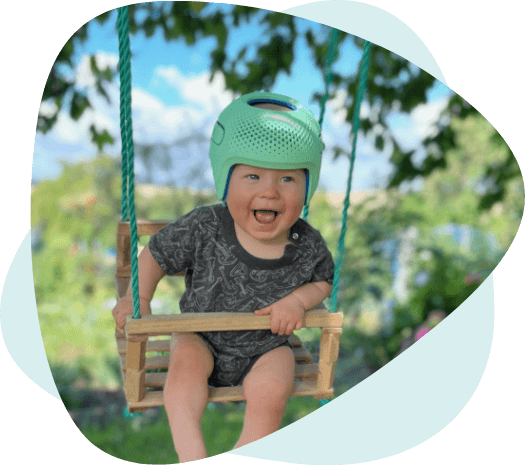Brachycephaly
- Home >
- Head Abnormalities >
- Brachycephaly
What is brachycephaly?
Brachycephaly is a word that describes a head shape that is wider than normal.
Looking down on the top, a normal head shape looks a little like an egg, narrower at the front, slightly wider at the back and longer front to back than the width.
The most common type of brachycephaly is called positional brachycephaly which can develop in early infancy if a baby is lying with the head in one position for long periods of time. Some babies have larger heads, this is normal but parents should make sure that an early flat spot doesn't start to develop as it can become more pronounced over time.

What are the typical symptoms?
The most common features describing a brachycephaly are a very wide head shape, sometimes wider than it is long from front to back. The head shape can be quite pushed up and high at the back with a slope down to the forehead and a prominent brow.
Why does it happen to babies?
A brachycephalic head shape can develop for several reasons. If the baby is 'back to back' in utero, with the back of the head lying across the mother's spine, this can cause the start of brachycephaly. It can develop after birth if the baby is lying for long periods in one position.
Often, a brachycephaly can be asymmetric and if the baby has a torticollis, a tightening in one side of the neck muscles, a combination brachycephaly / plagiocephaly can develop.
What challenges does it create for the child and their parents?
While brachycephaly is typically not a serious health concern, it naturally is a cause for concern for parents.
Brachycephaly itself won't cause any discomfort but it could cause difficulties if the person wants or needs to wear protective helmets in childhood or adulthood.
Socially, parents can be concerned about peer integration in childhood.
What happens if a baby goes untreated?
Untreated brachycephaly won't get any worse after 12 to 18 months of age and as the child grows it could reduce moderately in childhood.
Severe brachycephaly needs to be corrected early and won't have time to resolve without early intervention.
Recommended treatments
There are several treatment options available for brachycephaly, including repositioning, tummy time, and helmet therapy.
Repositioning and Tummy Time:
Repositioning and tummy time are the first recommended courses of treatment.
You can also reduce pressure on your baby’s head by frequently repositioning them to make sure there is not too much pressure applied to a single spot, and encouraging play on their tummy.
Read more about repositioning and tummy timeBenefits of helmets:
Repositioning and tummy time are important first steps when you notice a flat spot on your baby’s head. However, more severe cases of brachycephaly may require helmet therapy to correct.
Cranial remoulding helmets apply gentle control to the baby’s head as it’s growing. This directs the head to grow in the correct shape. Cranial remoulding treatment is very effective in reshaping babies’ heads while they are young and growing quickly.
An expert clinician can advise if your baby needs helmet therapy.
Find out more about cranial remoulding helmetsWhat to do if you think your baby might have brachycephaly
If you are concerned about your baby’s head shape, book a free pre-assessment and our expert clinicians will advise you.
Need more advice? Visit our support page for more information.
Our experts are happy to answer all your questions and provide the best solutions.